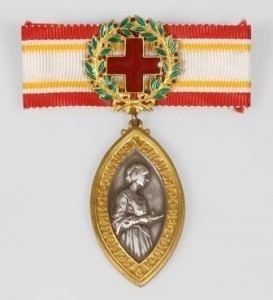Status Currently awarded. Established 1912 | Post-nominals FNM | |
 | ||
Type International nursing decoration (both military & civilian). Awarded for "Exceptional courage and devotion to the wounded, sick or disabled or to civilian victims of a conflict or disaster" or "exemplary services or a creative and pioneering spirit in the areas of public health or nursing education". Description Gold & silver medallion with the inscription 'Ad memoriam Florence Nightingale 1820-1910' suspended from a red cross encircled by green laurel. Similar Florence Nightingale effect, Florence Nightingale Museum, Nightingale Pledge | ||
At the Eighth International Conference of Red Cross Societies in London in 1907, the assembled delegates decided to create a commemorative International Nightingale Medal to be awarded to those distinguished in the nursing field. Subsequently, the Florence Nightingale Medal was instituted in 1912 by the International Committee of the Red Cross. It is the highest international distinction a nurse can achieve and is awarded to nurses or nursing aides for "exceptional courage and devotion to the wounded, sick or disabled or to civilian victims of a conflict or disaster" or "exemplary services or a creative and pioneering spirit in the areas of public health or nursing education".
It was initially set up to be awarded to six nurses annually, although the first 42 awards were only made in 1920 due to the disruption of the First World War.
The medal was restricted to female nurses until regulation changes in 1991. Under the new regulations it is open to both women and men, and is awarded every two years to a maximum number of fifty recipients worldwide. The vesica piscis-shaped medal is composed of gold & silver-gilt and bears a portrait of Florence Nightingale surrounded by the words 'Ad memoriam Florence Nightingale 1820-1910'. On the reverse, the name of the recipient and the date of the award are engraved, surrounded by the inscription 'Pro vera misericordia et cara humanitate perennis décor universalis' ('true and loving humanitarianism - a lasting general propriety'). The medal is attached to a white and red ribbon by a clasp featuring a red enamel cross encircled by a green laurel crown. Recipients are also presented with a parchment diploma of the award and, from 1927, a miniature version of the medal that could be more easily worn. The medal and a diploma are usually presented by the Head of State at a ceremony in their own country, which is required to have "a formal character, in keeping with the founders' wishes".
In 2007, the 41st set of medals were awarded to 35 recipients from 18 countries.
In 2009, the 42nd set of medals were awarded to 28 recipients from 15 countries, (including one for the first time to a nurse in Afghanistan.
In 2011, the 43rd set of medals were awarded to 39 recipients from 19 countries, (including for the first time to two Kenyan nurses).
In 2013, the 44th set of medals were awarded to 32 recipients from 16 countries, including one posthumously to a delegate from the British Red Cross.
In 2015, the 45th set of medals were awarded to 36 recipients from 18 countries, including one posthumously to a Sierra Leonian nurse who had worked in an ebola treatment centre.
